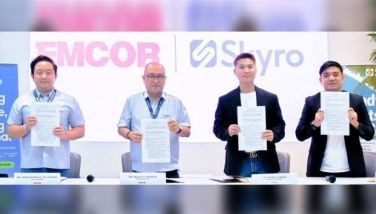Right time for renewables
August 5, 2002 | 12:00am
"Choose positive energy now." This is the battle cry of Greenpeace, an international environmentalist group currently on a tour of the Philippines and Thailand on its ship, M/V Artic Sunrise.
"There are alternative energy fuels that are adaptable to the Philippines. The present overcapacity is timely to put in these new plants that are not harmful to the environment," said Athena Ballesteros, campaign coordinator for Greenpeace Southeast Asia Phils.
These alternative sources of energy or renewables are wind, solar and biomass.
Based on several country-specific studies Greenpeace has conducted, the Philippines has a huge potential of 70,000 megawatts of wind power that can be developed. Places where wind power is perfect include Boracay island, which has recently been suffering from power outages.
Because of their agricultural base, there are lots of biomass materials such as rice hulls, coconut husks and sugarcane bagasse in Luzon and the Visayas. Based on Greenpeace studies, there’s a potential of 10,000 MWs of biomass energy which can tapped over several years.
"The only reason why fuel fossils like coal and oil are cost competitive is because they have already achieved economies of scale," said Anita Goldsmith, climate campaigner for Greenpeace UK. "More important, about $500 billion in government subsidies are being spent on these fossil fuels, which are harmful to the environment. If the $500 billion are spent on the research and development of renewable sources of energy, then the cost will definitely be competitive."
Given its current power overcapacity, the Philippines is in a better position than other countries to take a closer look at the economics of renewable energy.
"What we want is for government to shut down the old, decrepit plants like Calaca, which we found have been emitting mercury or quicksilver into the waste stream," said Ballesteros. "We have to act now or it will be too late. Already, the hole in the ozone layer is getting bigger. In 10 to 20 years, the effects on the climate and environment will be catastrophic."
To keep the environmental balance, the world has to keep intact one-third of its fossil fuel reserves.
"We are not unrealistic," said Ballesteros. "We know government has contracts with some power producers for about 20 years. What we can do is make better use of it by increasing their efficiencies, using energy conservation technologies such as efficient light bulbs and appliances as well as energy management methods like demand side management or DSM while slowly shifting to renewables."
Based on the Philippine Energy Plan, the share of new and renewable energy development is expected to drastically decrease from 30.03% today to 21.69% by 2011.
Greenpeace is, however, urging government to increase its renewable energy target by 10% and to reduce the volume of coal-fired power nationwide during the same period. It also seeks tax breaks and incentives for renewables, on the one hand, and changes in the present tax system that favor fossil fuels, on the other hand.
"There are alternative energy fuels that are adaptable to the Philippines. The present overcapacity is timely to put in these new plants that are not harmful to the environment," said Athena Ballesteros, campaign coordinator for Greenpeace Southeast Asia Phils.
These alternative sources of energy or renewables are wind, solar and biomass.
Based on several country-specific studies Greenpeace has conducted, the Philippines has a huge potential of 70,000 megawatts of wind power that can be developed. Places where wind power is perfect include Boracay island, which has recently been suffering from power outages.
Because of their agricultural base, there are lots of biomass materials such as rice hulls, coconut husks and sugarcane bagasse in Luzon and the Visayas. Based on Greenpeace studies, there’s a potential of 10,000 MWs of biomass energy which can tapped over several years.
"The only reason why fuel fossils like coal and oil are cost competitive is because they have already achieved economies of scale," said Anita Goldsmith, climate campaigner for Greenpeace UK. "More important, about $500 billion in government subsidies are being spent on these fossil fuels, which are harmful to the environment. If the $500 billion are spent on the research and development of renewable sources of energy, then the cost will definitely be competitive."
"What we want is for government to shut down the old, decrepit plants like Calaca, which we found have been emitting mercury or quicksilver into the waste stream," said Ballesteros. "We have to act now or it will be too late. Already, the hole in the ozone layer is getting bigger. In 10 to 20 years, the effects on the climate and environment will be catastrophic."
To keep the environmental balance, the world has to keep intact one-third of its fossil fuel reserves.
"We are not unrealistic," said Ballesteros. "We know government has contracts with some power producers for about 20 years. What we can do is make better use of it by increasing their efficiencies, using energy conservation technologies such as efficient light bulbs and appliances as well as energy management methods like demand side management or DSM while slowly shifting to renewables."
Based on the Philippine Energy Plan, the share of new and renewable energy development is expected to drastically decrease from 30.03% today to 21.69% by 2011.
Greenpeace is, however, urging government to increase its renewable energy target by 10% and to reduce the volume of coal-fired power nationwide during the same period. It also seeks tax breaks and incentives for renewables, on the one hand, and changes in the present tax system that favor fossil fuels, on the other hand.
BrandSpace Articles
<
>
- Latest
Latest
Latest
January 13, 2025 - 10:45am
January 13, 2025 - 10:45am
January 10, 2025 - 9:30am
January 10, 2025 - 9:30am
January 7, 2025 - 9:00am
January 7, 2025 - 9:00am
January 6, 2025 - 10:45am
January 6, 2025 - 10:45am
January 2, 2025 - 2:00pm
January 2, 2025 - 2:00pm
Recommended






























